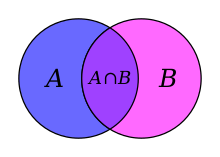Disjoint union
In mathematics, the disjoint union (or discriminated union) of a family of sets is a set with an injective function of each into A, such that the union of the images of these injections form a partition of A (that is, each element of A belongs to exactly one of these images).
The disjoint union of a family of pairwise disjoint sets is their set union.
In terms of category theory, the disjoint union is the coproduct of the category of sets.
The disjoint union is thus defined up to a bijection.
A standard way for building the disjoint union is to define A as the set of ordered pairs (x, i) such that and the injective functions by
Example
Consider the sets and . We can index the set elements according to set origin by forming the associated sets
where the second element in each pair matches the subscript of the origin set (e.g., the in matches the subscript in , etc.). The disjoint union can then be calculated as follows:
Set theory definition
Formally, let {Ai : i ∈ I} be a family of sets indexed by I. The disjoint union of this family is the set
The elements of the disjoint union are ordered pairs (x, i). Here i serves as an auxiliary index that indicates which Ai the element x came from.
Each of the sets Ai is canonically isomorphic to the set
Through this isomorphism, one may consider that Ai is canonically embedded in the disjoint union. For i ≠ j, the sets Ai* and Aj* are disjoint even if the sets Ai and Aj are not.
In the extreme case where each of the Ai is equal to some fixed set A for each i ∈ I, the disjoint union is the Cartesian product of A and I:
One may occasionally see the notation
for the disjoint union of a family of sets, or the notation A + B for the disjoint union of two sets. This notation is meant to be suggestive of the fact that the cardinality of the disjoint union is the sum of the cardinalities of the terms in the family. Compare this to the notation for the Cartesian product of a family of sets.
Disjoint unions are also sometimes written or .
In the language of category theory, the disjoint union is the coproduct in the category of sets. It therefore satisfies the associated universal property. This also means that the disjoint union is the categorical dual of the Cartesian product construction. See coproduct for more details.
For many purposes, the particular choice of auxiliary index is unimportant, and in a simplifying abuse of notation, the indexed family can be treated simply as a collection of sets. In this case is referred to as a copy of and the notation is sometimes used.
Category theory point of view
In category theory the disjoint union is defined as a coproduct in the category of sets.
As such, the disjoint union is defined up to an isomorphism, and the above definition is just one realization of the coproduct, among others. When the sets are pairwise disjoint, the usual union is another realization of the coproduct. This justifies the second definition in the lead.
This categorical aspect of the disjoint union explains why is frequently used, instead of , to denote coproduct.
See also
- Coproduct
- Disjoint union (topology)
- Disjoint union of graphs
- Partition of a set
- Sum type
- Tagged union
- Union (computer science)
References
- Lang, Serge (2004), Algebra, Graduate Texts in Mathematics, 211 (Corrected fourth printing, revised third ed.), New York: Springer-Verlag, p. 60, ISBN 978-0-387-95385-4
- Weisstein, Eric W. "Disjoint Union". MathWorld.
